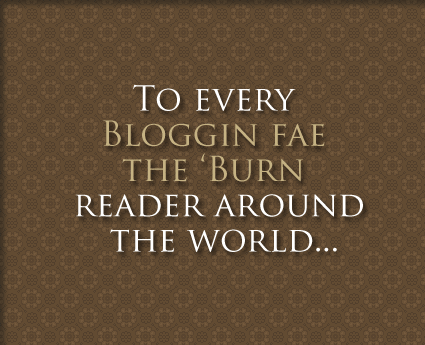I've been thinking about the recently-announced Titanic visitor centre in Belfast, which is due to be completed and opened in 2012 to coincide with the centenary of the ship's fateful launch and voyage. It was a momentous year for our wee country. The young CS Lewis had left his leafy East Belfast home four years previously for boarding school in England, returning regularly to his home city as she blossomed into a world industrial centre, and then a hotbed of political unrest.
By the end of the year, 500,000 people had signed the Ulster Covenant and Edward Carson had finalised his plans to establish the Ulster Volunteer Force. My own great-grandfather and his brothers signed it in Troon in Ayrshire (they must have been over there for the annual "Scotch Harvest"). You can search the Ulster Covenant database for your own ancestors signatures here.
Four famous pieces of creative writing summarise the Ulster experience of 1912, two poems and two hymns. Here are the two poems:
1. Ulster 1912 by Rudyard Kipling
The dark eleventh hour
Draws on and sees us sold
To every evil power
We fought against of old.
Rebellion, rapine, hate,
Oppression, wrong and greed
Are loosed to rule our fate,
By England’s act and deed.
The Faith in which we stand,
The laws we made and guard,
Our honour, lives, and land
Are given for reward
To Murder done by night,
To Treason taught by day,
To folly, sloth, and spite,
And we are thrust away.
The blood our fathers spilt,
Our love, our toils, our pains,
Are counted us for guilt,
And only bind our chains.
Before an Empire’s eyes
The traitor claims his price.
What need of further lies?
We are the sacrifice.
We asked no more than leave
To reap where we had sown,
Through good and ill to cleave
To our own flag and throne.
Now England’s shot and steel
Beneath that flag must show
How loyal hearts should kneel
To England’s oldest foe.
We know the war prepared
On every peaceful home,
We know the hells declared
For such as serve not Rome—
The terror, threats, and dread
In market, hearth, and field—
We know, when all is said.
We perish if we yield.
Believe, we dare not boast,
Believe, we do not fear
We stand to pay the cost
In all that men hold dear.
What answer from the North?
One Law, one Land, one Throne
If England drive us forth
We shall not fall alone!
2. The Blue Banner by W F Marshall
(Like many of his generation, Marshall took the Covenant imagery of 1638 and applied it to the Ulster experience of 1912 - a the time he was assistant minister at First Ballymacarrett Presbyterian Church in Belfast. This poem was printed in the Northern Whig on Ulster Day 28th September 1912 and would have been read by many thousands throughout Ulster as they made their way to sign the Ulster Covenant. Marshall even uses the Scots word "leal" rather than the English "loyal")
Firm-leagued we face the future, tho’ the road be dark and steep,
The road that leads to honour is the lonely road we keep,
And, though all the world forsake us, this is the course we hold,
The course our fathers followed in the Cov’nant days of old.
We fain would look for comfort to the land from whence we came,
Where still abide our kith and kin and clansmen of our name,
Where lives were deemed of small account by valiant men and true,
For Christ, His Crown, His Cov’nant and the war-worn folds of blue.
Long years have been and faded since the old-time banner waved,
See! How it flashes once again ere dangers must be braved,
The Cov’nant oath we now will swear that Britain may be told,
We stand for faith and freedom and the memories of old.
For all they died for gladly in the homeland o’er the sea,
For blood-won rights that still are ours as Ulsterborn and free,
For the land we came to dwell in, and the martyr’s faith we hold -
God grant we be as leal to these as were the men of old!
Sunday, December 28, 2008
Ulster 1912 - Part One
Friday, December 26, 2008
The Ten Commandments
I watched some of the amazing 1956 film "The Ten Commandments" this afternoon on More4. It was absolutely superb. The director, Cecil B DeMille, is said to have been the greatest movie director of all time. He was born into an Episcopalian family in the USA in 1881, and he suffered a near-fatal heart attack on the set of The Ten Commandments. Here's a quote from him, related to the series of great Biblical epic movies he made in the first half 20th Century:
"...All my life, I've wondered how many have been turned away from Christianity by the effeminate, sanctimonious, machine made Christ of Sunday school books. The Christ was actually a man with a body hard enough to withstand 40 days of fasting and long journeys on foot and nights of sleepless prayer, a man with a mind razor sharp, whose ranging thoughts measured the kingdoms of the world against the lilies in the field, a man who had compassion for sinners, and unleashed His anger and biting scorn only on the hyprocities who made a travesty of His father's temple. There could well have been a note of admiration in the voice of Pilate when he said of Him: 'Behold the Man!'..."
It's a far cry from "little Lord Jesus asleep on the hay"... And by the way, there was no stable. And no innkeeper. And no three Kings. This great wee cartoon bursts some of the storybook bubbles that have grown up around the Nativity story.
For the past few weeks I've been reading the story of Moses with my 10 year old son Jacob - not from picture story books, but directly from the Bible, chapter by chapter, taking a verse each. He has lapped it up, and watching the film this afternoon with him proved that even in today's age of computer special effects wizardry, it's the power of the story that really matters.
Monday, December 22, 2008
Sunday, December 21, 2008
The Psalm / Hymn tune "Ulster" by Robert Lowry

Written by the hymnwriter Robert Lowry (1826 - 1899) who was himself of Ulster descent, this tune features in Psalters and in many traditional hymnbooks, best known as the tune for the Fanny Crosby hymn "All the Way My Saviour leads Me". Click here to listen.
Lowry also wrote another Psalm tune which he named after himself, best known as the tune for "Saviour Thy Dying Love".
There is also a Psalm tune called Bangor. Here's a nice simple rendition of "Ulster" from Youtube:
Psalm tunes are of immense significance to Ulster-Scots culture, even in their emigration to America in the early 1700s:
"...the hold of the Scottish type of Psalmody was materially strengthened by the great volume of immigration from the North of Ireland. The Scotch-Irish brought with them The Psalms of David in meeter bound in with their Bibles, and to their minds almost a part of it. They had been accustomed to a Scriptural Psalmody as of course: few of them knew any psalm book but their own..."
from The English Hymn, Its Development and Use In Worship by Louis F Benson (Philadelphia 1915)
Saturday, December 20, 2008
Robert Burns and the Ulster visit legends
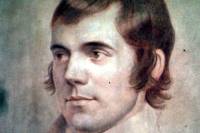
Jan 25th is Burns Night, and next year is a special one, the 250th anniversary of his birth. To tie in with this the Scottish Government has branded 2009 the year of Scotland's Homecoming. There are some Burns legends, of alleged but unproven visits to Ulster. As usual, one from County Antrim and one from County Down.
In the Ulster Journal of Archaeology, Sept 1894, this letter appeared:
................
Was Burns ever in Co. Antrim?
Some four or five years ago an old gentleman, now dead, told me that when he was a boy he knew an aged farmer who professed to have met Burns repeatedly in different parts of the north-east of Co. Antrim, at country jollifications especially, when the poet, he said, would sometimes sing his own songs for the company. According to this tradition he would seem to have been here "fou for weeks thegither". The point was thrown out to me by my informant as worth investigating. Since I first heard of it I have, at odd times, turned over a mass of Burnsiana in the hope of finding something that would corroborate the statement made, or disprove it; but my search has been fruitless. Can any reader help me to some light on this dark subject? I shall be much obliged for any information that this query may elicit. That Burns should cross to Co. Antrim is probable enough in itself for many reasons, but something better than abstract probability is desirable. To arrive at some record of the poet's sojourn in the North would be highly interesting, if he really did visit as alleged.
S.J.
................
The renowned antiquarian, academic and historian Rev George Hill replied to this over two pages in the Dec 1894 edition. Blurry digital pics of his reply are below. Sadly he dismisses the story.


There's another legend (told to me by Ian Wilson, who got it from the late Jack McCoy, the first local studies librarian at the library HQ in Ballynahinch) of Burns being invited to Donaghadee by an Ulster poet/fan. Donaghadee was the main "port of entry" from Scotland from 1606 - 1862. It is said that as Burns got off the boat and walked up the quayside, the Ulsterman spotted him and greeted him by saying something along the lines of:
"I can tell by your claes
An' the cut o' your hair
You're the bold Robert Burns
Fae the oul toon o' Ayr"
To which Burns responded in a similar spontaneous rhyme. They then retired to the famous Grace Neill's pub for some liquid refreshment!
Quite a few years ago there was a controversy when Belfast's Linenhall Library came close to quietly selling off its wonderful collection of Robert Burns material, the largest collection outside of Scotland. The collection of over 1000 books belonged to an Andrew Gibson, one of the most prominent Baptists of his generation. Thankfully the sale was prevented and the collection remains in Belfast. Perhaps it should be put on display to the public next year - yet another powerful example of the Ulster-Scots links.
Friday, December 19, 2008
Is Ulster-Scots a class issue?
Over the years I have found that the greatest objection to Ulster-Scots is neither political nor religious. It is in fact demographic. The toughest group to get the cultural message through to are "middle class Prods", the people who like to think of themselves as sophisticated and upwardly mobile. The type who have a weekend holiday home in North Antrim but who avoid any contact with the locals. They probably never eat egg & onion sandwiches any more - their developed palates prefer couscous and skinny lattés.*
This is not unique to Northern Ireland. The urban and suburban media, worldwide, loves to mock and patronise rural people and our ways.
Two examples: Sarah Palin was savaged by the oh-so-smart media who loved to characterise her as an Alaskan throwback. Her apparent lack of knowledge of international affairs was wrapped up with her rural roots. Google "Sarah Palin" with "hillbilly" and you'll get over 240,000 returns.
"Hillbilly" is a classic term of abuse used by the media to demean rural people. A quick visit to GoogleNews will bring up this story, of yet another American author who has chosen the Scotch-Irish folks of Appalachian Kentucky as his target.
So does this apply to Northern Ireland? I believe it does. For example, in David Adams' (ex-UDP) recent piece about identity in the Irish Times, he reverts to the unthinking stereotype of "...The recent invention of the deliberate - and deliberately exclusive - misnomer "Ulster Scots" is a laughably pathetic late attempt to fill this self-created vacuum..."
Many people who have cushy columnist jobs in the print and broadcast media have now reached a self-congratulatory pompous stage where cynicism is analysis, and where sarcasm is humour. And the only remaining group that it's socially acceptable to be prejudiced towards and to pour scorn upon is the rural people - in America the hillbillies, in Northern Ireland the Ulster-Scots.
Sure Ulster-Scots is just Ballymena people who can't speak properly - there is no 400 year Ulster-Scots literary tradition, is there?
Dear help these folk if they ever dare to venture further south than Newtownards. As the Chief Exec of a major public organisation who was reared in Ards told me just last week "when we were wee, we were told we should never go beyond the flood gates"!. The flood gates mark the edge of the town, and are the last glimpse of civilisation before entering the Low Country. There is an unspoken cultural Maginot Line that runs from the flood gates up to Six Road Ends, and down the Cottown Road into Donaghadee. South of that line... beyonde this pointe thar be dragons and country folk.
Finally, a story was told to me a few years ago by another civil servant, who in a previous job with the Housing Executive had to visit an elderly couple in their wee house in Portavogie. He was cautiously welcomed into their home, set down on the wee sofa, and the man and his wife then retreated to the kitchen. He overheard the wife whispering to her nearly-deaf husband "Noo Albert, you watch thon boyo - he's fae Bangor!"
Of course there are many fine, committed, Ulster-Scots enthusiasts in the towns and cities of Ulster. Ulster-Scots is not limited to rural life. My point is one of media portrayal, and of the attitudes that pervade their world. Comments would be welcome as thousands read this blog but hardly anyone posts!
..........
* forget fancy grub. There is no culinary joy that can compare with the mouth-watering saliva surge of biting into the heel of a plain loaf, folded in half, with country butter and homemade blackcorn (blackcurrant) jam in the middle!
.
Presbyterianism Through the Ages
It's funny how we (ie Ulster Protestant evangelical Ulster-Scots folk) have lost a lot of our creativity 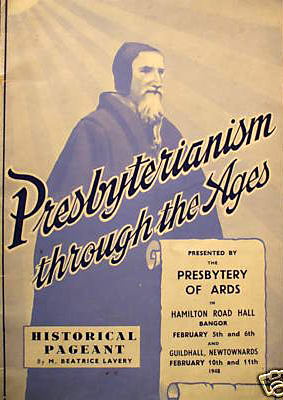 over the past few generations. We're "tighter", more reserved, less imaginative, wary of doing something new in case we get criticised - and until very recently, had forgotten our wonderful history. It's a strange situation, but it was once very different...
over the past few generations. We're "tighter", more reserved, less imaginative, wary of doing something new in case we get criticised - and until very recently, had forgotten our wonderful history. It's a strange situation, but it was once very different...
Back in February 1948, as Northern Ireland emerged from the poverty and loss of World War 2, the Presbytery of Ards performed an 18 scene drama entitled "Presbyterianism Through the Ages - a Historical Pageant". It was played over two consecutive nights in Newtownards, and then again in Bangor shortly afterwards. The script was written by M Beatrice Lavery, the secretary to the Moderator.
In the foreword, the Moderator wrote of how the Pageant "...vividly represents our stirring history, and links us with Brice and Livingstone, Blair and Hamilton*, Knox and Calvin..." (* - my friend from Ballywalter - I'm glad previous generations recognised his importance!)
The Pageant was performed not by professional actors, but by members of local congregations within the Presbytery, as follows:
.......................
Prologue - The Burning Bush - Rev J C Ferguson BA BD
Scene I - The New Testament Church; the Eldership - presented by Millisle and Ballyfrenis
Scene II - St Columba in Iona - presented by Second Newtownards and Regent Street
Scene III - John Calvin - presented by Rev W A A Park MA
Scene IV - John Knox and Mary Queen of Scots - presented by Trinity, Bangor
Scene V - Andrew Melville and James VI at Falkland Castle - presented by Kirkcubbin and Portaferry
Scene VI - Janet Geddes in St Giles' Cathedral, Edinburgh - presented by First Bangor and Conlig
Scene VII - The Signing of the National Covenant in Greyfriars Kirkyard, Edinburgh - presented by Hamilton Road, Bangor
Scene VIII - The Children's Bond - presented by Ballygilbert Guides and Brownies
Scene IX - A Conventicle (in the Pentland Hills) - presented by Ballywalter and Carrowdore
Scene X - The Killing Time - presented by Ballyblack Boys' Auxiliary
Scene X - The Last Martyr of the Covenant, James Renwick
Scene XI - Kirkbride (Scots language poem) - presented by Rev R J Laughlin BA, Mrs H Gilmore and Rev J Forbes BA
Scene XII - The First Presbytery in Ireland; the Army in Carrickfergus - presented by First Newtownards
Scene XIII - Closing of the Gates of Derry - presented by the Donaghadee Churches and Groomsport
Scene XIV - The Siege of Derry - presented by the Donaghadee Churches and Groomsport
Scene XV - King William III granting the Regium Donum at Hillsborough Castle - presented by Ballyholme and Helen's Bay
Scene XV - Rev Francis Mackemie; the Apostle of American Presbyterianism - presented by Miss Peggy Ferris
Scene XVI - Union of the Synods - presented by First Holywood and Ards Presbytery
Scene XVII - An Old-Time Service - presented by Greenwell Street, Newtownards
Scene XVIII - In Their Footsteps - presented by Trinity Bible Class
.......................
On the back cover is a message from Lord Tweedsmuir, which closes with the following statement:
"...You have heard and seen what Presbyterianism has been in the past; you know what it is today; its future - it depends on your realisation of your responsibility as an heir of such a magnificent heritage..."
Would a play like this happen today? Does the knowledge exist? Does the interest exist? The scripture text on the first page summarises it well:
"These days should be remembered and kept throughout every generation, every family, every province, and every city... nor the memorial of them perish from their seed..." Esther 9 v 28
.
Thursday, December 18, 2008
Big Christmas musical announcement!
A few weeks ago I promised there would be a musical announcement sometime around Christmas. Here it is - the amazing new album from the Thompson Brothers. Buy it today!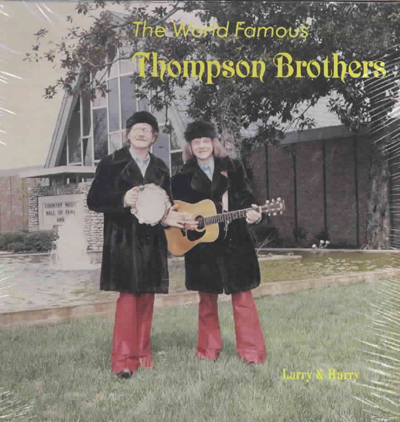
Monday, December 15, 2008
Can you see anything wrong with this photograph?
A real photo taken recently at the Royal Victoria hospital in Belfast - how long it will it take these guys to get home?
Friday, December 12, 2008
BBC Scotland: "Scotland's History"
Here's a link to a page on the BBC Scotland website, outlining the 5 recent broadcasts. I understand that 5 additional episodes will be broadcast in 2009. See the first 5 on BBC iPlayer here.
There are interesting references to John Knox in this overview of Mary Queen of Scots. As usual, beautifully filmed, dramatic landscapes, and presenter Neil Oliver combines knowledge, style and an excellent storytelling ability.
Maybe we should get him over here to record a 12 part series on Ulster-Scots history? Here's my list:
1. The Ancient Links
2. Robert the Bruce and Ulster
3. Hamilton & Montgomery Settlement
4. The Plantation and 1641
5. The Covenanters in Ulster
6. Derry, the Boyne and Emigration
7. The Ulster-Scots Revolutions - 1776 and 1798
8. The Weaver Poets, Language and Literature
9. Ulster-Scots in America
10. Ordinary Folk: Ulster-Scots folklife throughout the centuries
11. Belfast - a Scottish City
12. The Ulster Covenant, the Somme and the establishment of Northern Ireland
Of course all of these subjects would deserve a series of their own, never mind a half hour each. But a half hour each would be a good start, supported by a 12 deep websites and a six part radio series for each one.
Thursday, December 11, 2008
Cud Ye no Dae a Wee bit Mair for the Lord?
A few years ago, a big man called John Montgomery from Connor Presbyterian Church told me that the prayer meeting which is often claimed to have been the beginning of the 1859 Revival began because of the power of these words, which were spoken by the local minister to a young man who had recently been saved. I've been digging around trying to find a source for it. Here are a few:
• "... In the spring of 1855... at the close of a Sabbath evening of that period, at one of his Bible-class examinations, Mr Moore addressed a young man present, and affectionately urged upon him the duty of doing "something more" for God..."
from William Gibson's The Year of Grace, a History of the Ulster Revival of 1859 (1909)
The "something more" he encouraged them to do was Bible study - "reading and searching the word of God".
• "...Rev J H Moore, minister of the Connor congregation... was a great believer in setting his members to some definite work in the church and about this time he spoke to some of his more promising young men about taking up some such active work in the neighbourhood. "Do something more for God", he said to them..."
from Carson, God's River in Spate, Chapter II, p 7. (1958)
(The young men were James McQuilkin, Jeremiah Meneely, John Wallace and Robert Carlisle, who soon after began to run a Sunday School at Tanneybrake near Connor, and then a prayer meeting)
• "...It is interesting to note that the very month Jeremiah Lanphier commenced the Fulton Street Prayer Meeting in New York, September 1857 that four young men, James McQuilkin, Jeremiah Meneely, Robert Carlisle and John Wallace, began a weekly prayer meeting in the Old National Schoolhouse near Kells, not far from Ballymena. The Rev J H Moore had exhorted a handful of his young men to 'Do something more for God. Could you not gather at least six of your careless neighbours, either parents of children, to your house or some convenient place on the Sabbath and spend one hour with them, reading and searching the Word of God Each of them accepted the challenge and a Sabbath School and prayer meeting starter in a schoolhouse in Tanneybrake. Two months later the group moved: for the sake of convenience to a more central location in the Old National Schooihouse in Kells where they began to meet on a Friday night for the Believer's Fellowship Meeting..."
quoted from this blog
• "...In 1855 Rev. J. H. Moore, pastor of the Presbyterian Church in Connor, Northern Ireland, urged one of his young men to do "something more" for God. "Could you not gather at least six of your careless neighbors and spend an hour with them in reading and searching the Word of God?" The young man agreed to at-tempt "something more." And the result was the commencement of the Tannybrake Sunday school. After two years' labor, the teachers of this little school did again "something more." They asked the parents of the children to come to a meeting for prayer and Bible reading at the close of the school. Only one responded at first, but the meeting grew, and soon the Sabbath School Teachers' Prayer Meeting became intensely interesting, for the Spirit of God came pouring into this newly-opened channel. "Christ and the Cross" became the one absorbing theme of the gathering..."
from Old Time Revivals by John Shearer (1932)
Authors don't often write in the vernacular, so I expect that Gibson tidied up the original quotation into standard English, which has then been repeated over the years by subsequent writers. Rev JH Moore of Connor and his brother Rev SJ Moore of First Ballymena were both local men. I expect they may well have spoken with the local folk in Ulster-Scots, and not necessarily theological college English. Anyway, I prefer it the way John Montgomery told it to me:
"Cud ye no dae a wee bit mair for the Lord?"
Tuesday, December 09, 2008
Catching up
Just getting caught up on a few things. Graeme and I were out singing on Sunday night - Stephen Jamison did a fine job with the preachin' as usual - and we played 5 old hymns. One lady came up to us at the end and said that we had brought tears to her eyes when we played one of them. Thankfully it wasn't because we were excruciatingly bad (!), but because it had been her father's favourite hymn and he sang it constantly when she was a wee girl.
We've also been invited to play a few songs for Radio Ulster's forthcoming New Years Eve Ulster-Scots special programme. Not sure we can fit it in though as it's pretty short notice - being recorded this week. Nice to be asked though!
I survived Seven Days on Sunday (got plenty of text messages from people after the programme had finished!), and it must have went okay - the BBC were on the phone again this afternoon to see if I would do some other radio stuff with them between now and Christmas. Hopefully it'll work out - the shopping's all done, Santa's been sorted out, but the weans are starting to get a bit twitchy with expectation.
Finally, for those of you who are in Belfast, make a point of travelling down Great Victoria Street in the evenings between this coming weekend and Christmas. I'm working with the Presbyterian Church to project massive Christmas-themed gospel messages onto the side of Church House. We did some testing this evening, the brightness and legibility are holding up well - hopefully these will make some impact on the late night shoppers and party revellers over the next 3 weeks.
Iver an oot for noo!
Monday, December 08, 2008
Cameron in Ulster
Not David Cameron (who was over here at the weekend) - I much prefer Richard Cameron. He preached in Ulster, and was reprimanded for a sermon he gave in Strabane in 1673. Utterly committed to his cause, after he published this declaration in the village of Sanquhar in 1680 he was a marked man. He was dead within a month - cut down by Royal troops in the moorland of Airds Moss between Cumnock and Muirkirk.
Forget David. Read about Richard!
Saturday, December 06, 2008
Busy weekend!
Blogging might be quiet for a day or two - we have Charlie's birthday party this afternoon (he'll be 6 on Christmas Day, but we try to have his party a few weeks early), I'm on the studio panel for Radio Ulster's Seven Days programme from 1 - 2 tomorrow afternoon, and then Graeme and I are out musicalising in Belfast tomorrow night. It's all go, so will report back when I can.
Thursday, December 04, 2008
OrangeChristian.net
I've only had a quick glance at this new website, but it looks like the three Grand Lodges of Ireland, Scotland and England are to be congratulated for their efforts.
Wednesday, December 03, 2008
Sandy Halliday's Sacred Scotch Solos
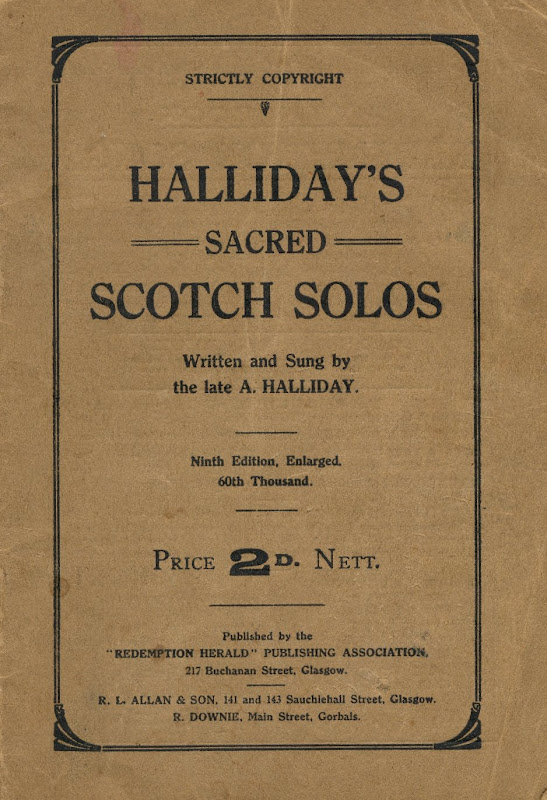
I was sent another copy of "Sacred Scotch Solos" recently, this time a different edition from someone in Canada. It has a lovely biography of the author/compiler, Sandy Halliday:
................
"...In issuing this revised and enlarged edition of Sacred Scotch Solos, written by the late Mr. Alexander Halliday, we feel that a few notes regarding the writer will not be out of place. He was of but humble Scottish birth, with no advantage to fit him for the battle of life, but one, i.e. a mother who feared God and made Alexander a child of prayer. Like many other such mothers, she had the sorrow of seeing him a wayward lad, but her faith failed not, and she doubtless was crowned with joy when in the middle of September, 1915, she could say in "the home on high," in the words of one of his own hymns :-
"This my son safe hame has come frae a faur kintree."
From the day of his conversion his was a joyful life. He could not keep from singing :-
"His life flowed on in endless song, above earth's lamentation,"
there was a great contagion in it. His songs were caught up and echoed far and wide - Canada, Australia, Africa, the trenches in France, and the rugged rocks of the Dardanelles have been made to resound with them. We cannot claim that there is any literary finish about them, but in some there is a happy heart lilt, in others a tender pathos, and in nearly all, a note of urgent invitation to the Saviour he himself had found so powerful and so precious.
"Sandy Halliday," as he was popularly known, did not confine his efforts to hymn-writing and hymn-singing, but he was wholehearted in all aggressive Christian work, especially labouring in the Anderston district of Glasgow in association with the Anderston Working Men's Mission. His labours with it extended over forty years. He was ever at home working amongst the children, and he will not be forgotten for at least another generation, because of the place he found in the heart of many a bairn. But we are sure that even when these are all gone, his Scotch Solos will still keep his memory green, and be sung far and wide to the glory of God and the Salvation of Souls..."
................
It includes an advert for Redemption Songs, and old editions of Redemption Songs that I have include adverts for two other old Scottish hymnbooks that I've found Scots language hymns in - Duncan McNeill's Hymn Book and Songs from the King's Highway. So there was obviously a wee cluster of evangelicals, and small publishing industry, in the late 1800s and early 1900s producing all of this material - and all printed by Pickering and Inglis.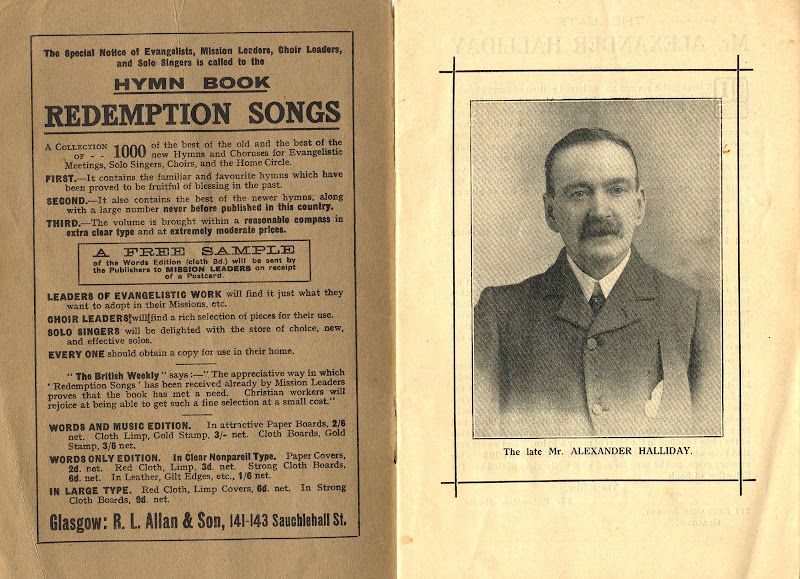
Click below to read the biography, and on the facing page the last ever hymn that Sandy wrote.
Branding the Shankill
Branding is usually commissioned by intellectual middle-class people, who hire intellectual middle-class people to create brands that are targeted at intellectual middle-class people. Consequently most branding is slick, glossy, "aspirational" - and sometimes shallow and contrived.
So what happens when a branding man from an ordinary working class background who isn't ashamed to admit a love for egg and onion sandwiches gets commissioned to create the first-ever brand for a world-famous loyalist working class district such as the Shankill Road?
The outcome was launched today in a lunchtime event at the Shankill Library, and it looks something like this...
(all media enquiries should be directed to Roz Small at the Greater Shankill Partnership on 028 9050 4555)
Tuesday, December 02, 2008
Irishness, identity and "Three Wee Ulster Lassies"
I see that today's News Letter front page story reports that "Northern Irish", as an option between "Irish" and "British", is rapidly gaining popularity. I'm not so sure about it yet - I first heard it about 10 years ago, around the time of the Belfast Agreement, and I'm still getting used to it. I suppose at least it's an improvement on singular monolithic "Irishness", which as I've blogged before, doesn't really exist anyway.
Even the President of the Republic of Ireland recognises that - but Republican Sinn Fein don't. Below is a clip from YouTube of a 1946 promotional film, which clearly outlines that Northern Ireland is an blend of English, Scottish and Irish.
I have a lovely wee book from 1883 entitled "Three Wee Ulster Lassies - news from our Irish cousins". It's an allegory to help explain the complex Ulster situation to people in Great Britain. Its three characters are Bessie Stronge (the Ulster-Saxon), Jennie Scott (the Ulster-Scot) and Nelly Nolan (the Ulster-Kelt).
Jennie Scott is said to have been "reared on oatmeal and the Shorter Catechism... such were Jennie and her friends. You can see a touch of the grim humour in their face, sarcasm in their lips and eyes, and independence on their brows. They have been taught to aim high, and if you looked at the little girl's face, you might learn that her family mean business and would stand no nonsense".
Later on, Jennie is interviewed:
Q: And what makes you like Scotland?
Jennie: What makes makes me like Scotlan'! Why shouldn't I like Scotlan'! Isn't Scotlan' the lan' o' Knox and Cameron - the land o' psalms and sangs - the country o' the Covenanters wha stood up for their rights, and were afeard o' naebody! That's why I like Scotlan'!
Jennie closes by saying:
I like Irelan' weel enough; but there are so many folk - some running after gentry, some after priests - that my faither says he would rather hae Scotlan', whar "a man's a man for a' that!".
Buy a copy for yourself here on Abebooks.com
Is Jewish identity an invention?
According to Israeli academic and historian Dr Shlomo Zand of Tel Aviv University it may well be. His book When and How Was the Jewish People Invented? has been top of the bestseller lists in Israel for the past six months. It's only available in Hebrew and French at the moment, but there are plenty of reviews online - here's another from Haaretz from back in March.
Monday, December 01, 2008
Lewis Headrick and the Do-Re-Mi Singers
This is a video clip from October 1996, at the Museum of Appalachia's Tennessee Fall Homecoming Festival. Every year old-time gospel music plays a major part in this event - Hilary and I sat spellbound the following year when we visited on our honeymoon. When we got home I wrote to Lewis, and he was good enough to send me a videotape of 2hrs of the previous year's singing. He also sent me a copy of their hymn book. I digitised the tape, and will be uploading it all song-by-song onto YouTube.
This is in a wee log cabin church that has been relocated to the museum grounds - a great place if you ever get the chance to visit. There's a bit of old traditional shape-note singing here as well.

